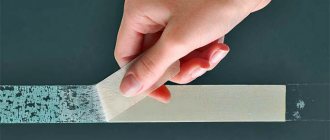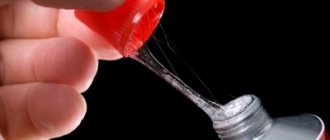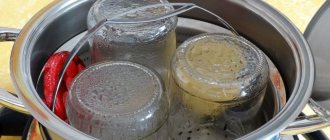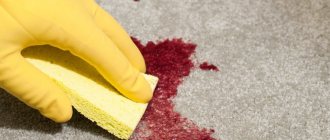Carrying out repairs, dyeing hair, doing arts and crafts and other work often lead to getting your hands dirty.
Removing paint can be very difficult. Chemical and mechanical methods come to the rescue.
Let's figure out how to remove stamp, construction, art, and hair dye from your hands.
How can I remove it?
There are three main ways to wash paint off your hands:
- Products with an abrasive effect, such as washing powder.
- Natural solvents (for example, citric acid).
- Chemical solvents (gasoline, acetone, etc.)
Removing the coloring agent by any of the methods, to a greater or lesser extent, negatively affects the skin of the hands, which then needs to be moisturized and nourished with the help of creams.
Gasoline and kerosene
Gasoline (preferably purified) and kerosene can act as effective solvents. They should be used carefully, avoiding smearing the substance on the skin of your hands that is not stained with paint.
Application:
Soak a rag in kerosene or gasoline.- Rub the stained areas on your hands for a minute.
- Rinse with water.
- Wash your hands with soap.
- Pat skin dry.
- Apply hand cream.
The advantage of the cleaning method is efficiency.
There are also disadvantages:
- toxicity of the substance itself and its fumes;
- irritating effect on the skin;
- not recommended for use in children.
Acetone
This substance belongs to the universal cleaners. It is used to remove contaminants.
Apply it directly to the areas of contamination and rub for a few seconds, then wash your hands with soap.
Acetone has an unpleasant, pungent odor, but it is good at removing polyurethane dyes and silicone sealant residues from hands and other surfaces. The advantages and disadvantages of acetone are the same as the previous method.
Oil products
In cases where the skin is stained with acrylic, enamel and nitro-enamel, oily, fatty substances can be used for cleaning.
For use you can choose:
- vegetable oils;
- melted butter;
- melted margarine;
- animal fat.
Advantages of this method:
- Environmentally friendly.
- Harmlessness.
- When rubbing a greasy product, you don’t have to be afraid that it will get on unstained skin - it won’t cause any harm.
- Can be used even by children.
There is only one drawback - poor efficiency . In order for the fat applied to the skin to remove the paint, you need to rub it in for 5 to 10 minutes.
The oil may not be effective against some stains, or when the skin on your hands is significantly dirty.
How to remove with washing powder?
The abrasive property of the powder is used to clean hands. The effect is achieved by purely mechanical action on the stains.
Procedure:
- Apply a small amount of powder to the area where your hands are dirty;
- rub;
- wash off.
The disadvantage of this method is its negative impact on the skin of the hands. The sharp edges of the grains during active friction not only destroy the paint layer, but also injure the skin.
Intensive cleaning may damage the skin - the formation of abrasions and wounds that will have to be further processed and treated.
Instead of washing powder, the following substances can be used: salt, soda and even sugar.
Toothpaste
The active substances in toothpaste can also serve as a means of removing paint from hands.
Mode of application:
- Wet your hands with water.
- Squeeze a small amount of toothpaste onto the stained hand.
- Use the fingers of your other hand to rub the paste into the stain.
It is not advisable to use pastes with a strong menthol effect for removal, as they can cause irritation.
Lemon acid
The use of natural acids is one way to remove paint from skin. Despite its natural origin and use, even in cooking, citric acid is quite caustic if applied directly to the skin.
For treatment, it is convenient to use a napkin or sponge (if the stain is very small) . After removing the dye using acid, you must wash your hands. You can also use acetic acid.
Alcohol
Preparations containing alcohol can serve as solvents if no other means are at hand.
Suitable for cleansing:
- vodka;
- medical alcohol;
- alcohol-based antiseptics, etc.
Application:
- Apply an alcohol-containing substance to the paint using a napkin.
- Process for about 10 minutes.
- If the alcohol has evaporated and the napkin has dried, it is moistened again.
- Wipe your hands with a rag.
- Wash your hands with soap.
- Apply hand cream.
Alcohol dries out the skin of your hands.
Solvents
Special preparations that are designed specifically for a specific type of paint are one of the best ways to clean your hands quickly. For this purpose , a solvent is selected, on the basis of which the coloring composition itself was made .
Upon contact with the paint, the chemical used is absorbed into it, destroying it, and transforming it into a liquid, easily removable state.
To apply the solvent to dirty hands, you can use, depending on the size of the stained area, a rag, sponge or cotton swab.
Procedure:
- Moisten a swab or rag generously in solvent.
- Carefully and gently wipe the stains on your hands. Excessive force should not be used so as not to further injure the skin.
- Rub for no more than 60 seconds. During this time, the paint, dissolving, will begin to transfer to the rag.
- If the used rags become significantly stained, a new rag is taken for processing. This is necessary so as not to stain your hands with paint again.
- After the hands are cleaned, they are washed using toilet soap to remove the chemical from the skin.
- Apply a rich cream to your hands.
It should be borne in mind that solvents are very aggressive chemicals, skin contact with which must be kept to a minimum.
Acetone
This product is quite often used in everyday life , as it is a universal cleaner for any contaminants. Paint is no exception. Acetone perfectly removes stains from hands without leaving any residue. However, it smells unpleasant, is toxic and flammable. Therefore, it is recommended to use it with cotton wool or cloth, adhering to safety precautions.
Removing paint from hands using acetone
Features of removing various types of coloring agents
The best result of hand cleansing can be obtained if you know exactly what composition left the stains. Even inks such as stamp inks and those used in printers require a separate approach to removal.
Refill for printer and printing
If the printer toner is water-based, then fresh stains can be washed off the skin with regular running water . Be sure to wash your hands with cold water.
Otherwise, instead of washing, you can get the opposite result - fixing the color.
You can additionally use laundry soap, washing powder, or a brush to clean your hands.
Toner manufacturers provide for the dye to set when exposed to high temperatures, which is why you should not wash your hands in hot water.
The principle of operation of inkjet printer inks, which are made on an oil basis, is to impregnate layers of paper.
The same thing happens with the skin of your hands. When washing, it is possible to wash off only the top layer of dye .
The pigment will disappear completely only after a few days. One option for using home remedies is to use a recipe based on washing powder and citric acid. You can speed up the process by washing your hands frequently.
In addition to the methods listed, it is recommended to use products that are designed to remove printing and other types of inks.
- special cleaner Strong & Safe Flexographic ink Hand Cleaner;
- Fast Orange Pumice Bar Hand Soap;
- deep cleaning lotions, etc.
Construction and art
You can remove stains left by water-based paints from your hands by washing your hands with soap and water. If the pigment is difficult to remove, it is recommended to rub the skin with the hard side of a washcloth or brush.
For acrylic, nitro enamel and enamel, the role of solvent is played by:
- acetone,
- petrol,
- White Spirit.
Oil products can also be used. The water emulsion, if it has dried, can be washed off by washing your hands with washing powder and using a brush. Caustic washes and paint thinners should not be used to clean hands, as they can cause chemical burns.
For hair
You can remove hair dye from your hands by simply washing with water if the problem was noticed right away.
Over time, you will have to use either a professional remover or put into practice recipes based on oil products, citric acid, washing powder, etc.
How and with what to remove paint from a child’s hands (without solvent)
The delicate skin of children requires a special approach in getting rid of traces of paint. The use of aggressive solvents can severely damage the skin, so their use is strictly prohibited.
If a child gets paint on his hands, first try to wash it off with soap and water. Otherwise, you can use nail polish remover without acetone, mayonnaise or sunflower oil. The latter, according to many parents, copes with the task most effectively.
Thus, you can get rid of traces of paint in different ways. Some of them are more effective, others less so. However, using any of them will really help in getting rid of pollution.
Important Tips
When removing oil paints, you should adhere to the following recommendations:
Consider the type of surface. The method of removing the coloring composition will depend on this.- Protect respiratory organs, skin of hands and mucous membranes when working with chemical compounds.
- Ventilate the room if the cleaning product has a pungent odor.
- Before using the new composition for the first time, test it on a small area.
- Before removing paint, remove dust and other contaminants from the surface.
When working with removers and caustic substances, it is advisable to use glass containers. Not all materials can withstand the effects of chemicals.
Toothpaste
It is not recommended to use menthol and mint paste for cleansing.
Such products often cause irritation and rash . Therefore, you should give preference to pasta with green tea, calendula or fruit.
It is worth remembering that an oral hygiene product can remove paint only at the drying stage . To do this, apply the paste to the stain and rub it until the skin becomes clean . After this, the treated area should be rinsed with water.
Removing paint with toothpaste
Fresh or dried paint on your hands can be removed in several ways. The most effective means are: solvent, acetone, refined gasoline, toothpaste and oil. Each option has its pros and cons, which should be taken into account at the time of use. Only in this case will it be possible to remove stains without harming the skin.
For more information on how to remove paint from your hands, watch the video:
Top 3 universal recipes
There are universal products that can be used in any situation, regardless of where exactly the oil paint ended up.
Laundry soap
The product contains acids, alkalis and fats. These three components are excellent at breaking down oil compounds.
Mode of application:
- Moisten the item that has the stain.
- Lather the soap.
- Apply it to the contaminated area.
- If the paint has dried, then leave the foam for 5-10 minutes to act.
- Rub the contaminated surface.
- Rinse off the composition with water.
Soap can be safely used on human skin; it can be used to wash various fabrics and clean wooden and plastic surfaces.











